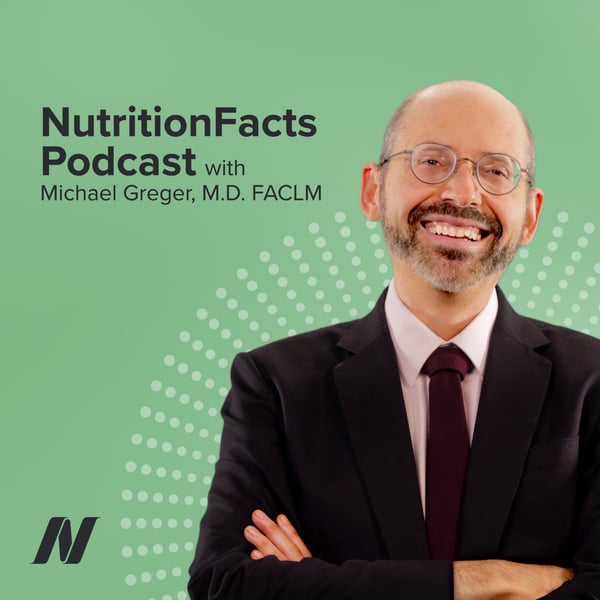COVID-19 Series: What Does the Clinical Course of COVID-19 Look Like?
Nutrition Facts with Dr. Greger
[email protected]
4.8 • 3.6K Ratings
🗓️ 1 October 2020
⏱️ 18 minutes
🧾️ Download transcript
Summary
This episode features audio from COVID-19 Symptoms vs. the Flu, a Cold, or Allergies and Modifiable Risk Factors and Comorbidities for Severe COVID-19 Infection. Visit the video pages for all sources and doctor's notes related to this podcast.
Transcript
Click on a timestamp to play from that location
| 0:00.0 | Welcome to the Nutrition Facts Podcast. I'm your host, Dr. Michael Greger. Many of us are feeling |
| 0:07.2 | helpless in the face of the current pandemic, but the good news is there are things we can do right now |
| 0:12.8 | to reduce our risk of falling seriously ill and dying from COVID-19 and preventing even greater |
| 0:18.9 | infectious disease threats in the future. What does the clinical course of COVID-19 look like? |
| 0:26.9 | It tends to start with fever and cough, but before then the average incubation period, the time |
| 0:34.6 | between the moment you get sufficiently exposed to the virus and the moment you start showing symptoms, |
| 0:40.6 | seems to be about five days. It's almost a week goes by when you're infected and potentially |
| 0:47.9 | infectious before you even know it. About 98% of those who are gonna start showing symptoms do so |
| 0:57.5 | by day 12, which explains why people are typically asked to self-quarantine for two weeks after |
| 1:04.2 | a potential exposure. After infection, apparent viral shedding may continue for more than a month |
| 1:11.9 | with an average of 20 days, though it's not clear how contagious survivors are, if at all, |
| 1:18.5 | during that extended time period. The most common symptoms are fever and cough, experienced by about |
| 1:25.4 | 90% and 70% of patients respectively, based on an analysis of more than 50,000 COVID-19 patients. |
| 1:34.4 | In terms of less common symptoms, only about four in 10 experienced fatigue, three in 10 |
| 1:41.0 | cough, up thlem, and two in 10 experienced muscle aches. Only about one in 10 suffer from gastrointestinal |
| 1:49.0 | symptoms such as nausea, vomiting, or diarrhea, or common cold type symptoms like running or stuffy |
| 1:56.3 | nose, headache, or a sore throat. This is consistent with the regional concentration of ACE-2, the |
| 2:04.4 | receptors the virus latches onto in the lungs rather than the nose or throat, though in pangolins, |
| 2:11.5 | ACE-2 is found on their flicking antider tongues. The only COVID-19 symptom found predictive of a |
| 2:17.6 | more severe course was difficulty breathing, which resulted in more than six times the odds of |
| 2:24.6 | eventually having to be admitted into the ICU. That's why that's such an important symptom to catch |
| 2:31.7 | early and a red flag to immediately seek medical attention. If it's going to strike, shortness of |
... |
Please login to see the full transcript.
Disclaimer: The podcast and artwork embedded on this page are from [email protected], and are the property of its owner and not affiliated with or endorsed by Tapesearch.
Generated transcripts are the property of [email protected] and are distributed freely under the Fair Use doctrine. Transcripts generated by Tapesearch are not guaranteed to be accurate.
Copyright © Tapesearch 2025.

